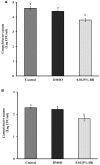Application of β-Resorcylic Acid as Potential Antimicrobial Feed Additive to Reduce Campylobacter Colonization in Broiler Chickens
- PMID: 28428779
- PMCID: PMC5382206
- DOI: 10.3389/fmicb.2017.00599
Application of β-Resorcylic Acid as Potential Antimicrobial Feed Additive to Reduce Campylobacter Colonization in Broiler Chickens
Abstract
Campylobacter is one of the major foodborne pathogens that result in severe gastroenteritis in humans, primarily through consumption of contaminated poultry products. Chickens are the reservoir host of Campylobacter, where the pathogen colonizes the ceca, thereby leading to contamination of carcass during slaughter. A reduction in cecal colonization by Campylobacter would directly translate into reduced product contamination and risk of human infections. With increasing consumer demand for antibiotic free chickens, significant research is being conducted to discover natural, safe and economical antimicrobials that can effectively control Campylobacter colonization in birds. This study investigated the efficacy of in-feed supplementation of a phytophenolic compound, β-resorcylic acid (BR) for reducing Campylobacter colonization in broiler chickens. In two separate, replicate trials, day-old-chicks (Cobb500; n = 10 birds/treatment) were fed with BR (0, 0.25, 0.5, or 1%) in feed for a period of 14 days (n = 40/trial). Birds were challenged with a four-strain mixture of Campylobacter jejuni (∼106 CFU/ml; 250 μl/bird) on day 7 and cecal samples were collected on day 14 for enumerating surviving Campylobacter in cecal contents. In addition, the effect of BR on the critical colonization factors of Campylobacter (motility, epithelial cell attachment) was studied using phenotypic assay, cell culture, and real-time quantitative PCR. Supplementation of BR in poultry feed for 14 days at 0.5 and 1% reduced Campylobacter populations in cecal contents by ∼2.5 and 1.7 Log CFU/g, respectively (P < 0.05). No significant differences in feed intake and body weight gain were observed between control and treatment birds fed the compound (P > 0.05). Follow up mechanistic analysis revealed that sub-inhibitory concentration of BR significantly reduced Campylobacter motility, attachment to and invasion of Caco-2 cells. In addition, the expression of C. jejuni genes coding for motility (motA, motB, fliA) and attachment (jlpA, ciaB) was down-regulated as compared to controls (P < 0.05). These results suggest that BR could potentially be used as a feed additive to reduce Campylobacter colonization in broilers.
Keywords: Campylobacter jejuni; cell culture; chickens; colonization factors; gene expression; pre-harvest safety; β-resorcylic acid.
Figures






Similar articles
-
β-Resorcylic Acid, a Phytophenolic Compound, Reduces Campylobacter jejuni in Postharvest Poultry.J Food Prot. 2017 Aug;80(8):1243-1251. doi: 10.4315/0362-028X.JFP-16-475. J Food Prot. 2017. PMID: 28686495
-
The natural feed additive caprylic acid decreases Campylobacter jejuni colonization in market-aged broiler chickens.Poult Sci. 2009 Jan;88(1):61-4. doi: 10.3382/ps.2008-00228. Poult Sci. 2009. PMID: 19096058 Clinical Trial.
-
The Role of Dietary Supplementation of Yeast Cell Walls in Response to a Campylobacter jejuni Inoculation in Broiler Chickens.Avian Dis. 2023 Sep;67(3):245-253. doi: 10.1637/aviandiseases-D-23-00003. Avian Dis. 2023. PMID: 39126411
-
Use of plant-derived antimicrobials for improving the safety of poultry products.Poult Sci. 2013 Feb;92(2):493-501. doi: 10.3382/ps.2012-02764. Poult Sci. 2013. PMID: 23300319 Review.
-
Poultry as a host for the zoonotic pathogen Campylobacter jejuni.Vector Borne Zoonotic Dis. 2012 Feb;12(2):89-98. doi: 10.1089/vbz.2011.0676. Epub 2011 Dec 1. Vector Borne Zoonotic Dis. 2012. PMID: 22133236 Review.
Cited by
-
Sodium Butyrate Reduces Salmonella Enteritidis Infection of Chicken Enterocytes and Expression of Inflammatory Host Genes in vitro.Front Microbiol. 2020 Sep 16;11:553670. doi: 10.3389/fmicb.2020.553670. eCollection 2020. Front Microbiol. 2020. PMID: 33042060 Free PMC article.
-
Antimicrobial effect of a drinking water additive comprising four organic acids on Campylobacter load in broilers and monitoring of bacterial susceptibility.Poult Sci. 2022 Dec;101(12):102209. doi: 10.1016/j.psj.2022.102209. Epub 2022 Sep 25. Poult Sci. 2022. PMID: 36283144 Free PMC article.
-
Review of Antibiotic Resistance, Ecology, Dissemination, and Mitigation in U.S. Broiler Poultry Systems.Front Microbiol. 2019 Nov 15;10:2639. doi: 10.3389/fmicb.2019.02639. eCollection 2019. Front Microbiol. 2019. PMID: 31803164 Free PMC article. Review.
-
Select Phytochemicals Reduce Campylobacter jejuni in Postharvest Poultry and Modulate the Virulence Attributes of C. jejuni.Front Microbiol. 2021 Aug 12;12:725087. doi: 10.3389/fmicb.2021.725087. eCollection 2021. Front Microbiol. 2021. PMID: 34456896 Free PMC article.
-
Natural Antimicrobial Mixtures Disrupt Attachment and Survival of E. coli and C. jejuni to Non-Organic and Organic Surfaces.Foods. 2023 Oct 21;12(20):3863. doi: 10.3390/foods12203863. Foods. 2023. PMID: 37893756 Free PMC article.
References
-
- Arsi K., Donoghue A. M., Woo-Ming A., Blore P. J., Donoghue D. J. (2015). The efficacy of selected probiotic and prebiotic combinations in reducing Campylobacter colonization in broiler chickens. J. Appl. Poult. Res. 24 327–334. 10.3382/japr/pfv032 - DOI
-
- Baskaran S. A., Upadhyay A., Kollanoor Johny A., Upadhyaya I., Mooyottu S., Amalaradjou M. A. R., et al. (2013). Efficacy of plant-derived antimicrobials as antimicrobial wash treatments for reducing enterohemorrhagic Escherichia Coli O157: H7 on apples. J. Food Sci. 78 M1399–M1404. 10.1111/1750-3841.12174 - DOI - PubMed
LinkOut - more resources
Full Text Sources
Other Literature Sources

